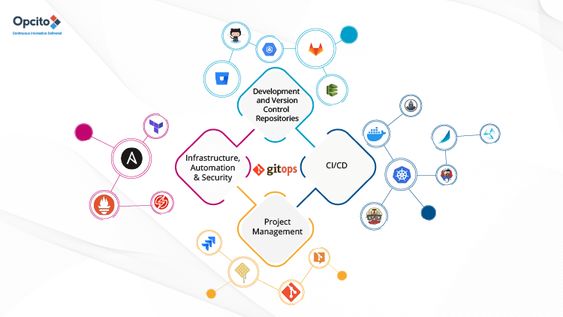GitOps for DevOps: The Ultimate Guide to Streamlined Infrastructure Management
 Hashir Ahmad
Hashir Ahmad
The DevOps landscape is a dynamic ecosystem constantly seeking innovative approaches to streamline workflows, enhance collaboration, and deliver value faster. Among the emerging trends, GitOps is rapidly gaining traction, redefining how we manage and deploy infrastructure as code (IaC). This blog dives deep into the world of GitOps, exploring its core principles, benefits, and real-world applications. We'll also analyze a compelling case study, showcasing how a leading company leveraged GitOps to boost efficiency and agility.
Before GitOps: A Messy Infrastructure
Prior to the emergence of GitOps, infrastructure management was often a tangled web of complexity. Configurations were scattered across various text files, scripts, and manual processes, making it difficult to maintain consistency and track changes. This lack of a centralized source of truth led to errors, inconsistencies across environments (development, staging, production), and challenges in collaboration. Troubleshooting issues became a time-consuming effort, as pinpointing the root cause often involved sifting through numerous disparate configurations. GitOps addresses these shortcomings by establishing a single source of truth for infrastructure configurations within the Git repository. This centralized repository ensures that all teams are working with the same set of configurations, minimizing inconsistencies and simplifying collaboration. Additionally, Git's version control capabilities allow for easy rollbacks and a complete audit trail of changes, promoting a more reliable and auditable infrastructure management approach.
Understanding the Core of GitOps
Imagine managing your infrastructure configurations the same way you handle your application code: using the power of Git, the ubiquitous version control system. That's the essence of GitOps. It promotes a declarative approach where you define the desired state of your infrastructure using IaC files (e.g., YAML, Terraform) stored in a central Git repository. This approach removes the complexity of imperative commands and scripts, promoting consistency across environments.
Benefits of Embracing GitOps:
Enhanced Declarative Management: No more juggling complex scripts. GitOps lets you define your infrastructure state declaratively, ensuring a clear and concise representation of desired configurations. This simplifies management and promotes error reduction.
Improved Collaboration and Version Control: Git, with its robust branching and merging features, fosters collaboration among DevOps teams. Teams can work on infrastructure changes in isolation, review them through pull requests, and seamlessly integrate approved changes into the main branch.
Simplified Rollbacks and Disaster Recovery: Version control allows for easy rollbacks to previous configurations in case of issues during deployments. This rollback capability minimizes downtime and fosters a more risk-resilient approach.
Enhanced Auditability and Compliance: Git provides a complete audit trail of all infrastructure changes. This simplifies compliance efforts and allows teams to track who made what changes and when.
The Numbers Don't Lie: GitOps Adoption on the Rise
A 2023 survey by GitLab revealed a significant shift towards GitOps:
64% of respondents are already using or evaluating GitOps practices.
72% reported improved collaboration and communication within their teams after adopting GitOps.
68% experienced faster deployments and rollbacks with GitOps.
GitOps in Action: A Case Study of Increased Efficiency
Company: Acme Inc., a leading e-commerce platform.
Challenge: Acme Inc. faced a growing infrastructure complexity with manual configurations and disparate deployment processes across environments. This led to inconsistencies, slow deployments, and difficulty in managing rollbacks.
Solution: Acme implemented GitOps with Argo CD, a popular GitOps implementation tool. The team migrated all infrastructure configurations to a central Git repository. Argo CD continuously monitors the Git repository and automatically synchronizes the desired state with the actual infrastructure configuration.
Results: Acme Inc. experienced substantial benefits:
Reduced Deployment Time: With GitOps, deployments became faster and more predictable. The declarative approach eliminated the need for complex scripts and manual interventions.
Improved Collaboration: GitOps fostered collaboration across DevOps teams. Developers and operations teams worked on infrastructure changes seamlessly using Git branching and merging functionalities.
Enhanced Rollback Capability: Version control allowed Acme to easily revert to previous configurations if needed, minimizing downtime and ensuring smooth recoveries.
The Future of Infrastructure Management: Embracing GitOps
The GitOps approach signifies a paradigm shift in DevOps practices. By leveraging the power of Git for infrastructure management, organizations can unlock a world of benefits, including improved collaboration, streamlined deployments, enhanced auditability, and a more robust and auditable infrastructure. As DevOps continues to evolve, GitOps is poised to play a pivotal role in shaping the future of infrastructure management and application delivery.
Ready to Explore GitOps Further?
This blog post merely scratched the surface of GitOps. Here are some additional resources for your journey:
Getting Started with GitOps: https://about.gitlab.com/blog/2022/04/07/the-ultimate-guide-to-gitops-with-gitlab/
Argo CD Documentation: https://v0-6.kubeflow.org/docs/use-cases/gitops-for-kubeflow/
Case Studies of GitOps Adoption: https://www.gartner.com/en/documents/4302199
We encourage you to delve deeper into GitOps and explore how it can revolutionize your infrastructure management practices. Share your thoughts and experiences with GitOps in the comments below! Let's discuss the potential of GitOps to transform the DevOps landscape.
Subscribe to my newsletter
Read articles from Hashir Ahmad directly inside your inbox. Subscribe to the newsletter, and don't miss out.
Written by
